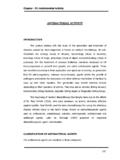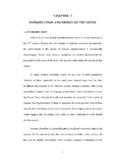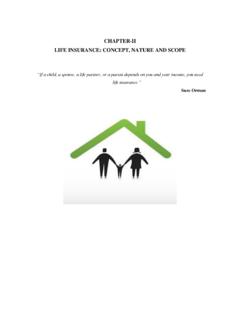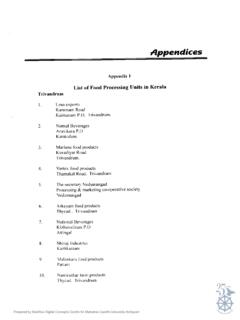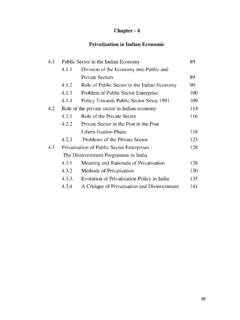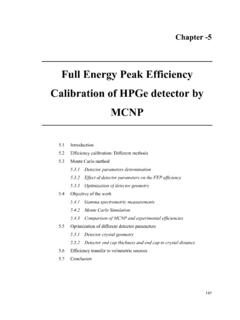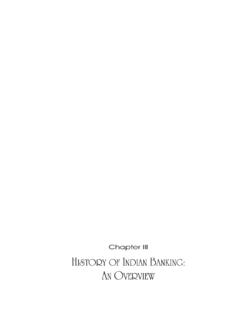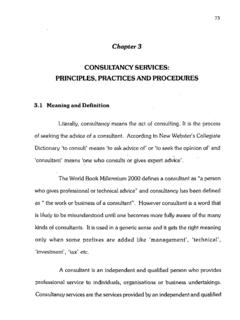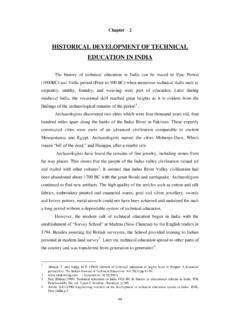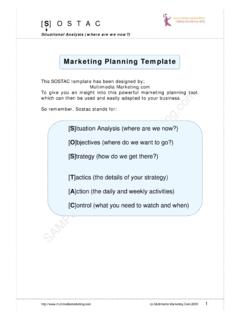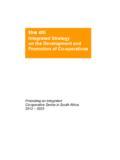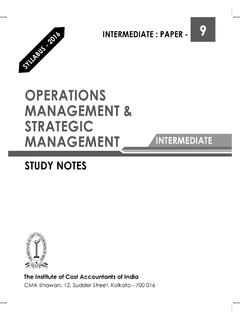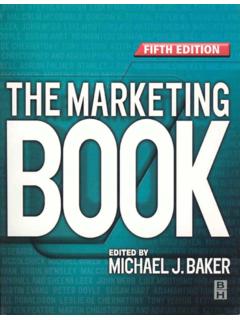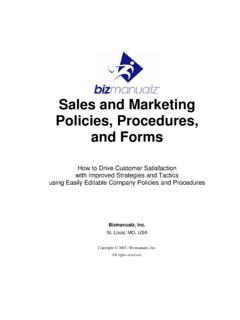Transcription of chapter 3 litreture review - INFLIBNET
1 chapter 3: Literature review ================================== ================================ Introduction:The previous chapter provided an overview of the world and Indian floriculture sector. The objective of this study is to find out whether Indian floriculture industry is sustainable and can it compete in the international markets. This chapter provides the theoretical framework and definitions which are relevant to this research. The objective of this literature review is reviewing some literature and theories which relevant to the research of this thesis. In this chapter a literature study will be done to bring out the theories related competitive advantage to be used as a base for the research. The literature review provides a theoretical framework that is used as a basis for executing the research and is presented in the following Theoretical frameworkThe comprehensive review of floriculture sector presented in previous chapter points out that the worldwide floriculture sector is competitive.
2 Barriers to both entering and exiting the sector are low. The costs of switching between suppliers or buyers and between flower varieties are also low. The flower production in most developing countries is destined for developed countries: the domestic market in developing countries is negligible. This put the challenges of the floriculture sector in the theoretical area of internationalization and competitiveness. The sustainability of the industry is therefore determined by the competitive advantages and the strategic theoretical framework that is outlined in this chapter is based on a literature search that provided input from a number of authors that have contributed to the field of strategic management. The mixture of input from the different authors provides a comprehensive framework for executing a strategic analysis that contributes to answering the main research question.
3 One group of authors, Boardman, Shapiro and Veining (2004), advocate that a strategic analysis should consist of three main analyses: the external analysis , the fulcrum analysis and the solution analysis . The framework developed by Boardman et al. (2004) outlines a number of detailed and sequential research steps that enable a researcher to execute a comprehensive strategic analysis that can be used to solve a strategic issue. In addition to Boardman et al. (2004) there are a number of other authors that provide input for executing a strategic analysis , including: Porter (1980; 1985), Austin (1990) and Johnson, Scholes and Whittington ---------------------------------------- ---------------------------------------- ---------------------------------------- ---------------- chapter 3: Literature review Page no:79 (2008).
4 The objective of doing external environment analysis in this thesis is finding out the opportunity and threat to the floriculture sector in India and Pune. The understanding of external environment helps to analyze the competitive advantage provided and to device competitive strategies to help grasp the opportunities and prevent the threats. The external analysis will then analyze the focal firm s external environment as suggested by Boardman et al. (2004). The external environment could be divided into macro-environment and micro- environment. To help identify the strategic behavior it is necessary to conduct macro and micro analysis . To analyze the micro external environment Boardman et al. (2004) and Johnson et al. (2008) suggest using the five forces framework developed by Porter (1980). Austin (1990), adds four influential macro factors to Porter s original five forces framework.
5 The four factors include: economic, political, cultural and demographic factors. They are similar to the factors in the PESTEL-framework (political, economical, social, technological, ecological and legal) developed by Johnson et al. (2008). Hence PESTLE model analysis is used to scan the macro-environment, which considers the Political / legal environment, economic environment, social/ cultural environment, technological environment, and ecological / physical environment. These important forces jointly form the opportunities and threats to a company in its industry. (Jobber, 2004) Furthermore, Johnson et al. (2008) note that a SWOT (Strengths, Weaknesses, Opportunities and Threats) analysis is a useful tool to generate strategic options and assess the future course of action of a company. The SWOT analysis is a technique which is credited to Albert Humphrey (1969).
6 It is a transparent planning instrument that can identify important problem areas for a company. It also enables a company to learn about the current situation and reflect on what can be done to improve the current situation (Sorensen, Vidal, & Engstr m, 2004). The objective of using SWOT analysis in this dissertation is providing a list of strength, weaknesses, opportunities, and threats . After analyzing the external and internal environments, the firm is able to decide which competitive strategies should be used to achieve its competitive objective. The competitive strategies could be used to exploit opportunities in the firm s environment with the firm s strength, and neutralizes threats in the firm s environment while avoiding the firm s weaknesses (Barney, 2007, P12). PEST is rarely applied alone, as the information provided is more useful while complementing another analysis .
7 Combined with SWOT, for example, PEST helps to ---------------------------------------- ---------------------------------------- ---------------------------------------- ---------------- chapter 3: Literature review Page no:80 understand the risk associated with launching a particular product into a market (Schildhouse, 2006).The third and final part of the situational analysis as described in the generic framework developed by Boardman et al. (2004) is the current strategy analysis . It analyzes the focal firm s current strategy for judging and taking advantage of the opportunities within a competitive strategies are used to gain competitive advantage, which aims to outperforming other firms in an industry, and earn a higher rate of profit than the industry norm. (Barney, 1991) For pursuing a competitive advantage Porter (1980, 1985) identified three generic strategies: a cost leadership strategy, a differentiation strategy and a focus , Porter s Five Forces, and SWOT all utilize basic frameworks for reviewing a situation (Chapman, 2005).
8 The objective of literature review in this thesis is reviewing some literature and theories which relevant to the research of this dissertation. Figure provides the theoretical framework and a list of literature and theories, which will be covered in this *of*Conceptual*framework**RESEARCH'DESIG N''''**Desk*research*on*Indian*Floricult ure*Industry*and*Literature* review *on*In ternationalization*&**Competitive*Strate gies*Pestle* analysis *and*Swot* analysis *E xternal*Environment*Internal*Environment *Integrate*external*and*internal*analysi s*BusinessC*level*strategies**Macro'envi ronment:*PEST* analysis :*analyzing*the*re lationship*between*the*firm*and*its*macr o*environment.*Micro*environment:*Porter s*fiveCforce*framework:*for*understandin g*the*industry*and*the*sectors*as*the*so urce*of*Competition*SWOT*is*introduced*f or*examining*the*opportunities*and*threa ts*to*each*firm*through*its*strength*and *weakness*Generic*Strategics*Create*Surv ey*Questionnaire*Survey*on*floriculture* firms*in*Pune*Data*Entry*Data* analysis *R esult*Report*Managerial*Implication**Lim itations*and*Conclusions*Fig Theoretical framework and Outline of this chapterHence the next sections of this chapter provide an literature review of PESTLE , Porters Five force model, SWOT and Porters generic strategies.
9 This is followed by a brief review of Internationalization to give a better understanding of the research objectives. ---------------------------------------- ---------------------------------------- ---------------------------------------- ---------------- chapter 3: Literature review Page no:81 PESTLE AnalysisTools and techniques for environmental scanning were firstly discussed by Aguilar (1967) who defined it as a process that seeks information about events and relationships in a company s outside environment, the knowledge of which would assist top management in its task of charting the company s future course of action (Fahey & King, 1977). This external environment can be divided into the operating environment the suppliers and other interest groups, with which the firm deals, and the general environment the national and global context of social, political, regulatory, economic and technological conditions (Thomas, 1974).
10 Shortly after its publication, Arnold Brown for the Institute of Life Insurance (in the US) reorganized it as STEP (Strategic Trend Evaluation Process) as a way to organise the results of his environmental , this macro external environment analysis , or environmental scanning for change , was modified yet again to become a so-called STEPE analysis (the Social, Technical, Economic, Political, and Ecological taxonomies). In the 1980s, several other authors including Fahey, Narayanan, Morrison, Renfro, Boucher, Mecca and Porter included variations of the taxonomy classifications in a variety of orders: PEST, PESTLE, STEEPLE term PESTLE is particularly popular on HR and introductory marketing courses in the UK. Others favor PEST, STEP or STEEPLE. The growing importance of environmental or ecological factors in the first decade of the 21st century have given rise to green business and encouraged widespread use of an updated version of the PEST can be understood, PESTLE analysis concentrates on the general environment.
